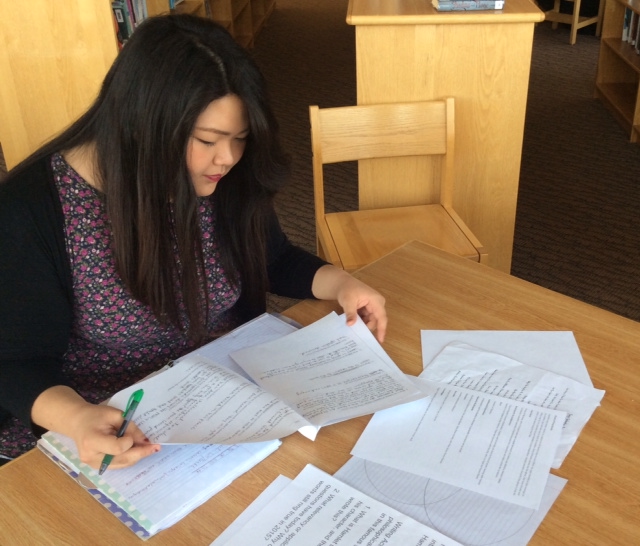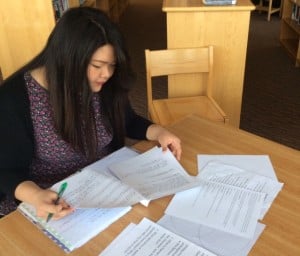Things have “gotten real” in my Economics class thanks to our new TAG specialist, Mrs. Virginia “Ginny” Hammes. About a month ago, she sent out an email soliciting volunteers to play the “Stock Market Game.” This game affords students the opportunity to buy and sale real stocks, bonds, and mutual funds online—in real-time, just like real day traders. The rules of this game are simple: each team begins with—“a small loan of”—$100,000, which they use to purchase stocks, bonds, and mutual funds. If they’re feeling lucky, they may borrow an additional $50,000 at 7% interest. Obviously, the object of the game is to make the most money possible, but the stakes of this game are higher: our Turner stock market teams are part of the “Capitol Hill Challenge,” which means that we are competing against 3,700+ teams across the nation. And the team who makes the most money by May 6th wins a trip—with their teacher—to Washington, D.C. How’s that for real?
The struggle is also real. As stock investors know, trying to make money in this market is difficult, but, as a teacher, this game is also stretching me beyond my comfort zone. First of all, I teach Economics, yet I’m not an expert on stocks and bonds—if I were I’d drive a much nicer car! I also had no clue, initially, about how to navigate the game’s website, nor any idea how to make purchases, sell stock, etc. Despite Mrs. Hammes gracious offers of help, I decided to just let my students muddle their way through the website, as I dropped hints about how/where to find stock tips and advice. That’s right: I let them struggle.
Why would I willingly place myself and my students aboard the “struggle bus”? The epiphany came to me the other day while reading Tony Wagner and Ted Dintersmit’s wonderful book Most Likely to Succeed: Preparing our Kids for the Innovation Era (2015). On page 198, Wagner and Dintersmit asked educators the provocative question: “Do you think your purpose is to teach students, or help them learn?” Before reading that quote, I hadn’t really thought much about the distinctions between teaching students and helping them learn. I had always assumed that by teaching I was helping them learn, but Wagner and Dintersmit cogently argued against that assumption. Overall, Most Likely to Succeed made the case that teachers need to teach students how to learn, which often means letting them struggle.
From my own experience, I know that I learn best from actively doing a thing, but it took a masters’ degree in American History, and a truly masterful teacher to help me fully realize that concept. Instead of merely telling me what to think or how to do history, my gracious thesis adviser put me to work: he gave me stacks of books to read, ideas to digest, writing assignments to do, and, seemingly, endless revisions to make to my thesis. While he never hesitated to tell me what he thought, it took a lot of independent work, time, effort, and research to form my own historical opinion. Simply put: regurgitating my professor’s opinion wasn’t evidence of learning, but my thesis was. Producing that product taught me how to think, write, and talk like a historian, which was the real reason why I went to grad school in the first place.
Teachers are an integral part of the learning process. After all, I could have just stayed home and read histories—that is, if I merely wanted to repeat others’ opinions. While that path would have saved me a lot of time, effort, and money, my professors taught me how to critically assess and deconstruct those same books. They did that by making me struggle, and in the process they made me a better learner and a better teacher.
Too often in public education we are crippled with self-doubt, or we overburden ourselves with learning tasks and preparation—work that really belongs to the student. I believe that those are situations that arise from the false notions that we must be experts of content and subject matter, and that we alone transmit knowledge into our students’ heads. Teaching students how to learn—by doing—is a powerful antidote to many of the ills that plague our self-esteem and our efficacy as teachers. So: when the struggle “gets real” don’t be afraid to jump into the trenches, and learn alongside your students. Above all, don’t be afraid to let them struggle—so long as you are there to lend them a friendly, helping hand.


“Teaching students HOW to learn… is a powerful antidote to many of the ills that plague…” Our society! Beautiful and true writing!
Thank you for taking the time to read my article, Jen! And your comment means a lot to me.
Jason, thank you so much for having your students participating in the Stock Market Game! Your post made my day!
Thank you for the invite, Ginny! This game is a great learning experience for myself and my students. And I really love the platform–it is so realistic.
Wonderful collaboration between Mr. McGee and Mrs. Hammes……..love hearing and reading about unique student experiences.
This is very inspiring! As I educate adults in my field of nursing I could use this as well! Glad you shared. Glad for your influence on these young minds and guidance to them.